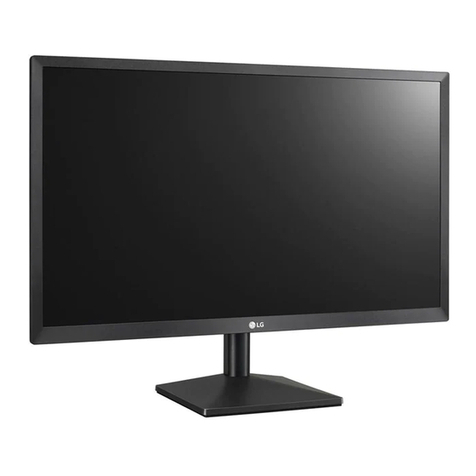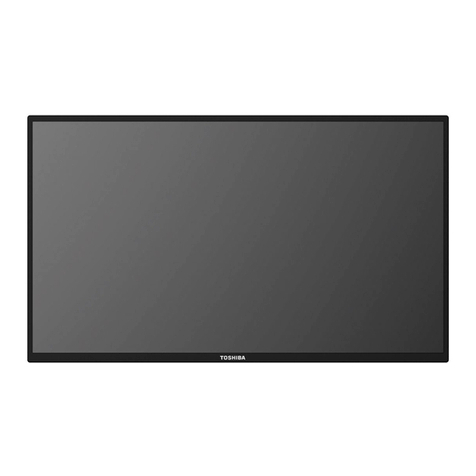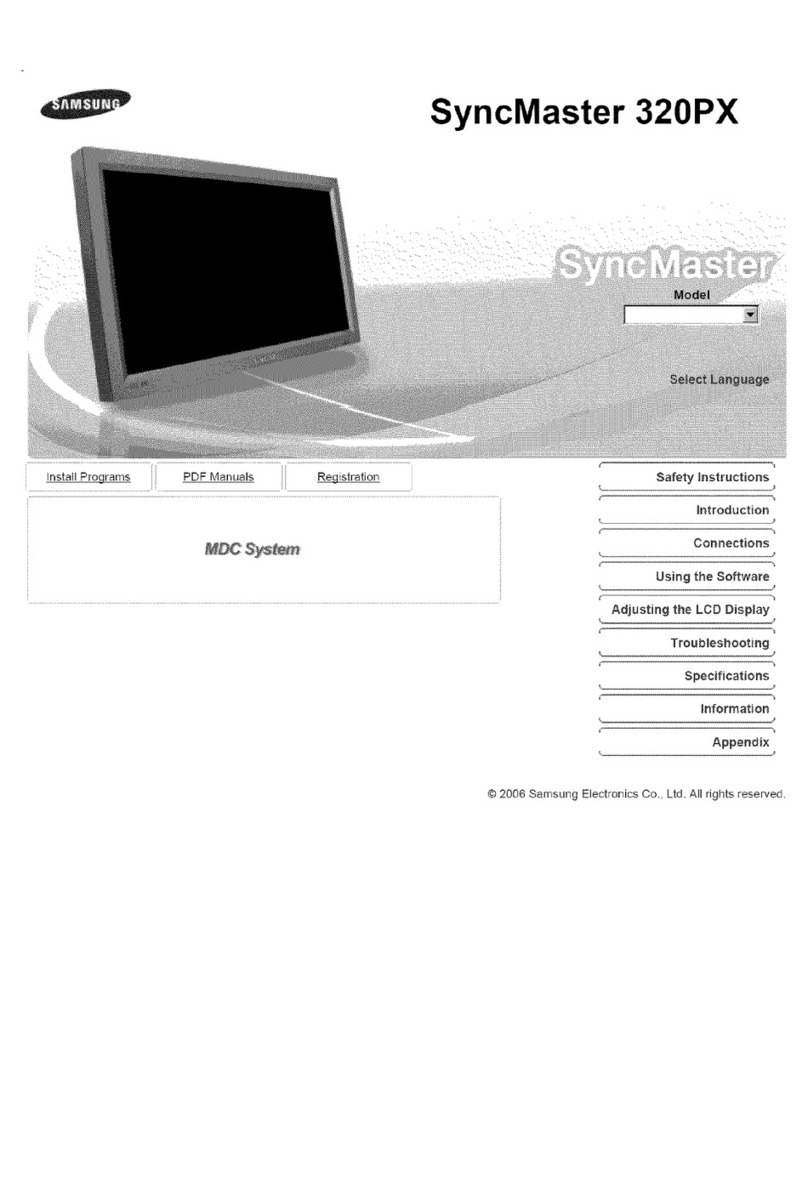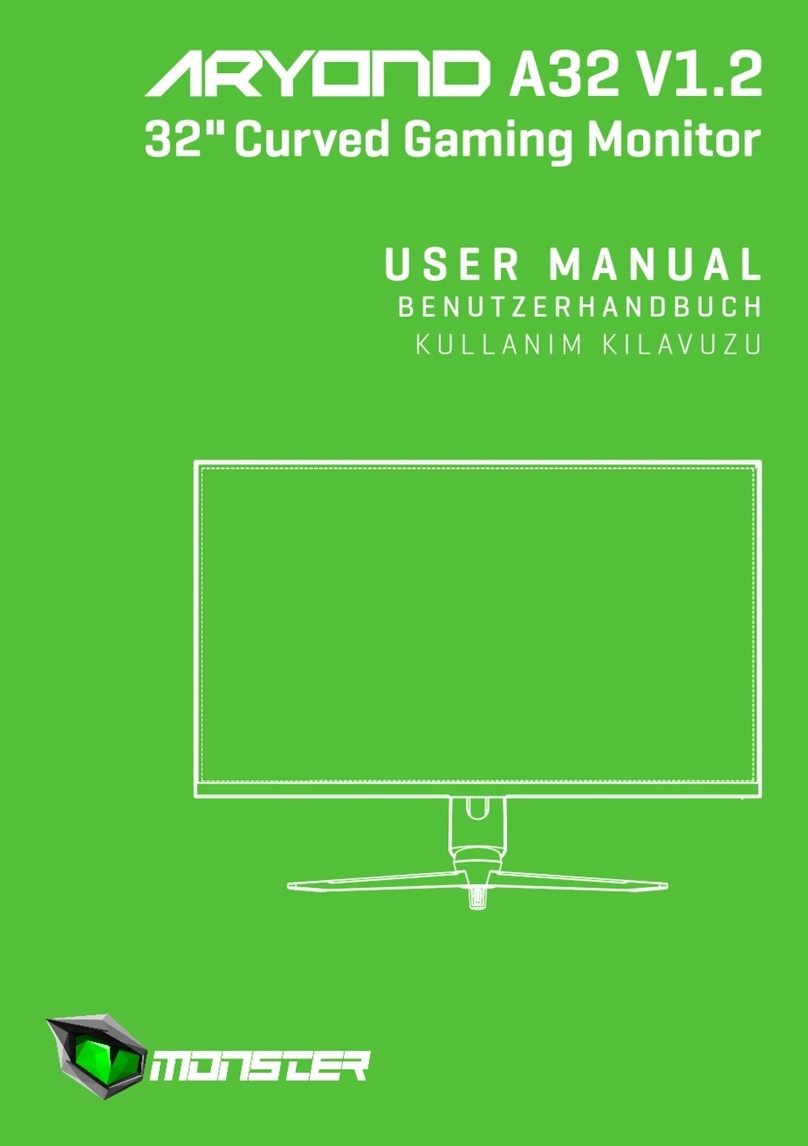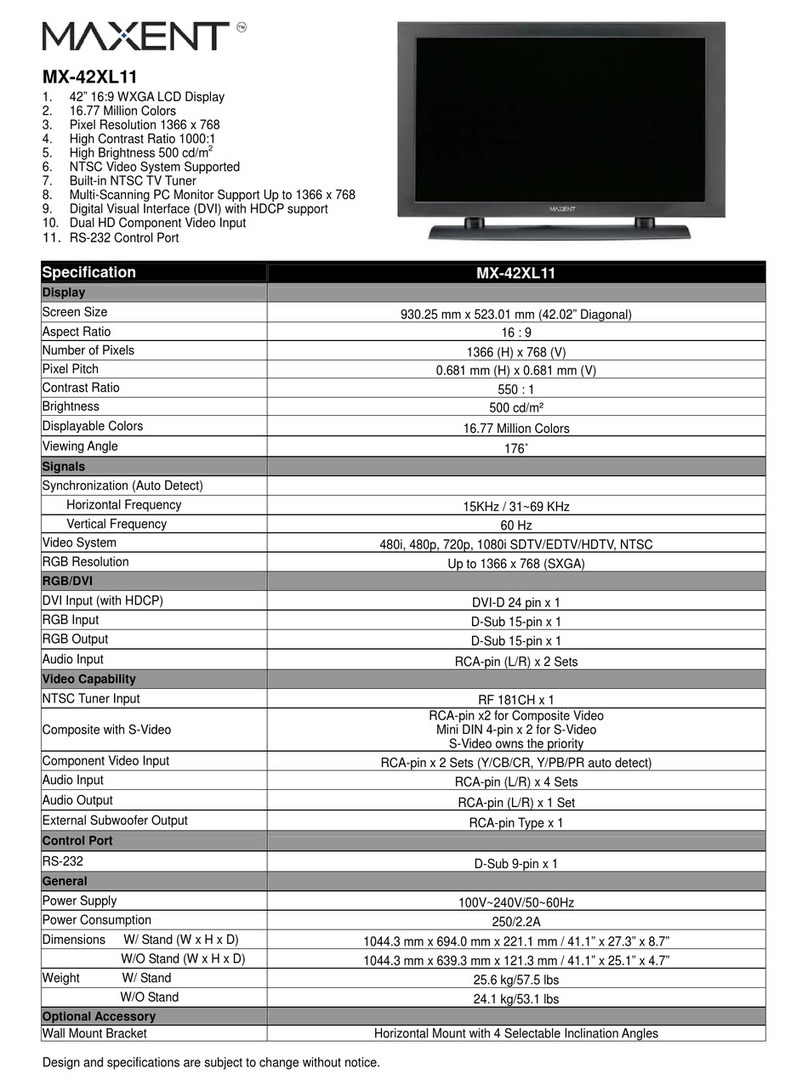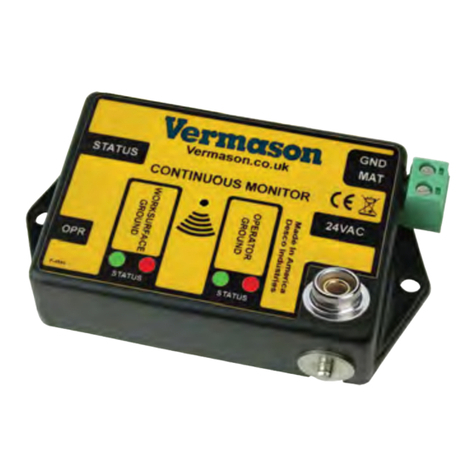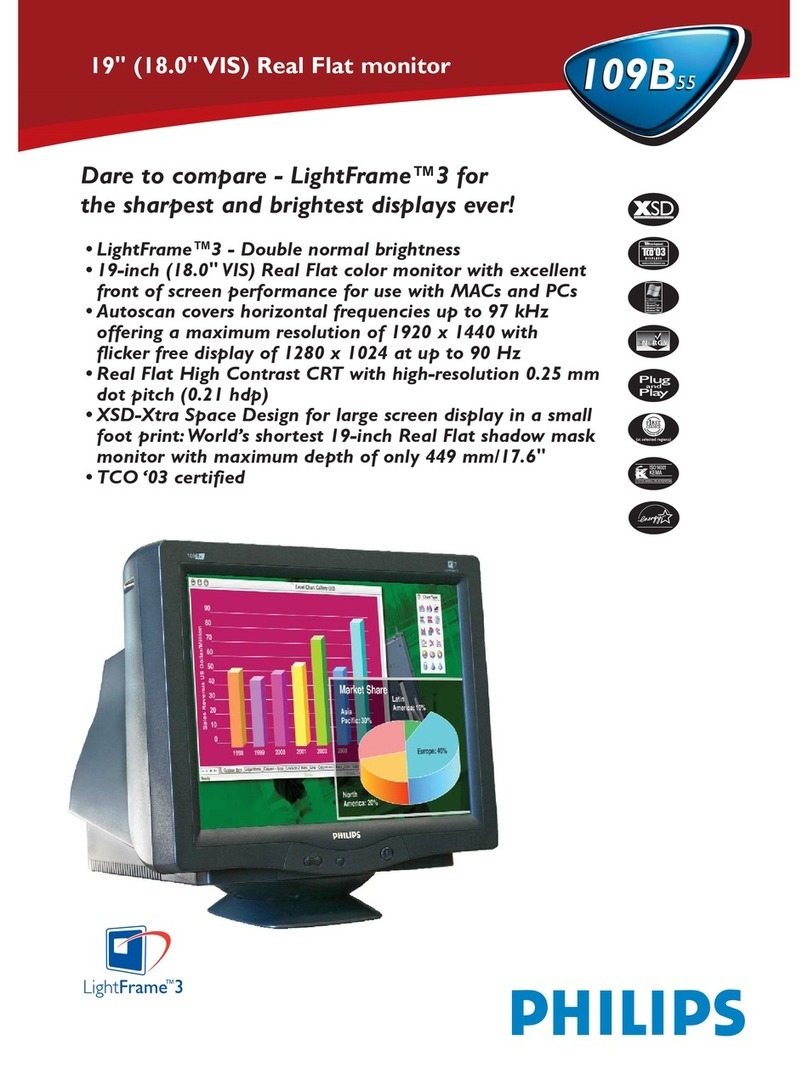EDI 2018KCL Series User manual

THIS MANUAL CONTAINS TECHNICAL INFORMATION FOR
THE 2018KCL and 2018KCLip,PCB Issue G.
Firmware Version 0156, 0456
REVISION: FEBRUARY 2016
pn 888-2018-001
- NOTE -
EDI ECCOM SOFTWARE MUST BE UPDATED TO VERSION 4.2 OR HIGHER.
EDI MONITORKEY SOFTWARE MUST BE UPDATED TO VERSION 2.4 OR HIGHER.
EDI SOFTWARE IS AVAILABLE AT WWW.EDITRAFFIC.COM
2018KCL Series
18 Channel RMS Signal Monitor with Datakey
Operations Manual

THE 2018KCL SERIES SIGNAL MONITOR UNIT IS DESIGNED AND MANUFACTURED
IN THE USA BY EBERLE DESIGN INC., PHOENIX, ARIZONA.
INFORMATION CONTAINED HEREIN IS PROPRIETARY TECHNICAL INFORMATION
OF EBERLE DESIGN INC. PUBLICATION, REPRODUCTION OR USE IN WHOLE OR
PART IS NOT PERMITTED EXCEPT UNDER TERMS AGREED UPON IN WRITING.
©COPYRIGHT 2016 EDI.
MAINTENANCE NOTE
EBERLE DESIGN INC. SIGNAL MONITORS HAVE BEEN CAREFULLY INSPECTED
AND TESTED TO ENSURE PROPER OPERATION. IT IS RECOMMENDED THAT THE
SIGNAL MONITOR BE TESTED AT LEAST ANNUALLY TO ENSURE COMPLIANCE
WITH THE PROPER SPECIFICATIONS.
SECTION 4.1.2, SPECIAL FUNCTION INPUTS
SPECIAL FUNCTION #2 HAS BEEN DISABLED TO PROVIDE COMPATIBILITY WITH
THE MT-180 MONITOR TESTER. RESISTOR R31 HAS BEEN REMOVED TO DISABLE
THIS CIRCUIT. IF SPECIAL FUNCTION #2 INPUT IS REQUIRED, R31 (150K OHMS,
1/2W) SHOULD BE INSTALLED.
- WARNING -
THE P1 RED INTERFACE CABLE SHOULD ALWAYS BE UNPLUGGED
BEFORE REMOVING THE UNIT FROM THE CABINET TO PREVENT
POTENTIAL EXPOSURE TO ELECTRICAL SHOCK.
- WARNING -
PIN 27 OF THE MAIN CONNECTOR PROVIDES THE CLOSED CONTACT OF
THE OUTPUT RELAY WHEN THE MONITOR IS IN THE NO-FAULT STATE.
WHEN THE MONITOR IS IN THE NO-FAULT STATE AND THE AUTO/FLASH
SWITCH IS IN THE FLASH POSITION, AC LINE VOLTAGE MAY BE PRESENT
ON PIN 27.
THIS PIN WAS PREVIOUSLY DEFINED AS A “NO-CONNECT’ PIN IN LEGACY
EQUIPMENT. TO PREVENT POTENTIAL EXPOSURE TO ELECTRICAL
SHOCK, BEFORE INSTALLING THIS MONITOR THE USER IS CAUTIONED
TO CHECK THAT THE CABINET WIRING IS COMPATIBLE WITH THE USE OF
THIS PIN AS A SOURCE OF AC LINE VOLTAGE.

TABLE OF CONTENTS
Section 1 BASIC FUNCTIONS.......................................................................................... 1
1.1 Model Description .................................................................................................. 1
1.2 Basic Functions...................................................................................................... 1
1.2.1 Datakey Parameter Programming................................................................. 1
1.2.2 Conflict Monitoring........................................................................................ 2
1.2.3 24VDC Monitoring (VDC).............................................................................. 2
1.2.4 Controller Watchdog Monitoring (WDT)......................................................... 2
Section 2 EXTENDED FEATURES................................................................................... 3
2.1 Hardware Features................................................................................................. 3
2.2 Red Failure Monitoring........................................................................................... 3
2.2.1 Red Interface Cable Fault ............................................................................. 4
2.3 GYR-Dual Indication Monitoring ............................................................................. 4
2.4 Clearance (Short or Absent Yellow) Monitoring ...................................................... 4
2.4.1 Minimum Yellow Change Interval.................................................................. 4
2.4.2 Minimum Yellow Plus Red Interval................................................................ 4
2.5 AC Line Brown-out Detection ................................................................................. 5
2.5.1 Minimum Flash Time..................................................................................... 5
2.6 LEDguard®LED Field Signal Sensing .................................................................... 5
2.7 Recurrent Pulse Detection...................................................................................... 6
2.8 Exit Flash............................................................................................................... 6
2.9 Non-Volatile Fault Memory..................................................................................... 6
2.10 KEY (Datakey Absent) Indication.......................................................................... 7
2.10.1 Datakey Memory Diagnostic........................................................................ 7
2.11 Configuration Change Monitoring......................................................................... 7
2.12 Internal MPU Watchdog ....................................................................................... 7
2.13 Reset Input Detection........................................................................................... 7
2.14 LED Test.............................................................................................................. 8
2.15 Memory Test........................................................................................................ 8
2.16 Watchdog Monitoring Disabled Indicator .............................................................. 8
2.17 Red Failure Monitor Disabled IndicatoR ............................................................... 8
2.18 Diagnostic Display Mode...................................................................................... 8
2.18.1 No Fault Diagnostic Display........................................................................ 8
2.18.2 Fault Diagnostic Display.............................................................................. 8
2.19 Flashing Yellow Arrow (FYA) Overview................................................................ 9
2.19.1 FYA Mode..................................................................................................10
2.19.2 FYAc (Compact) Mode...............................................................................12
Section 3 EVENT LOGGING FEATURES........................................................................17
3.1 Basic Front Panel Fault Event Display...................................................................17
3.2 Status and Event Reporting...................................................................................17
3.2.1 BI Tran Systems 233 Program Monitor Status..............................................17
3.2.2 EDI ECcom Monitor Report..........................................................................17
3.2.3 EDI ECcom Monitor Event Log Examples....................................................18
3.3 Signal Sequence Event Log ..................................................................................20
Section 4 INSTALLATION ...............................................................................................22
4.1 Adapting Red Monitoring.......................................................................................22
4.1.1 Red Field Inputs...........................................................................................22
4.1.2 Special Function Preempt Inputs (SF1,2).....................................................22
4.2 Datakey Parameters..............................................................................................23
4.2.1 Datakey Parameter Programming................................................................23
4.2.2 MonitorKey Configuration Set-up Wizard......................................................23
4.2.3 Unit Data Parameters...................................................................................23
4.2.4 Permissive Channel Pair Parameters...........................................................25
4.2.5 Red Fail Enable Parameters........................................................................25
4.2.6 Dual Indication Enable Parameters..............................................................25

4.2.7 Clearance Enable Parameters .....................................................................25
4.2.8 Yellow Disable Parameters..........................................................................25
4.2.9 Flashing Yellow Arrow (FYA / FYAc) Parameters.........................................25
Section 5 FRONT PANEL DESCRIPTION.......................................................................26
5.1 Indicators ..............................................................................................................26
5.1.1 AC PWR Indicator........................................................................................26
5.1.2 VDC Indicator ..............................................................................................26
5.1.3 WDT Indicator..............................................................................................26
5.1.4 CONFLICT Indicator ....................................................................................26
5.1.5 RED FAIL Indicator......................................................................................26
5.1.6 DUAL IND Indicator......................................................................................26
5.1.7 CLEARANCE Indicator ................................................................................26
5.1.8 KEY Indicator...............................................................................................26
5.1.9 DIAGNOSTIC Indicator................................................................................27
5.1.10 RP DETECT Indicator................................................................................27
5.1.11 COMM Indicator.........................................................................................27
5.1.12 CHANNEL STATUS Indicators...................................................................27
5.2 Front Panel Controls .............................................................................................27
5.2.1 RESET Button..............................................................................................27
5.3 Red Interface Connector (P1)................................................................................27
Section 6 CIRCUIT OPERATION.....................................................................................28
6.1 Introduction ...........................................................................................................28
6.2 Main MPU Logic....................................................................................................28
6.3 Serial Peripheral Interface (SPI)............................................................................28
6.4 Internal MPU Watchdog ........................................................................................28
6.5 EEprom Memory...................................................................................................28
6.6 24Vdc Logic Inputs................................................................................................28
6.7 Real Time Clock....................................................................................................29
6.8 Display..................................................................................................................29
6.9 RMS-Engine..........................................................................................................29
6.10 Power Supply......................................................................................................29
6.11 EIA-232 Communications Port ............................................................................29
6.12 Ethernet Communications Port............................................................................29
Section 7 TROUBLE SHOOTING.....................................................................................30
Section 8 SPECIFICATIONS............................................................................................32
8.1 Electrical ...............................................................................................................32
8.1.1 Power Requirements....................................................................................32
8.1.2 AC Voltage Monitors....................................................................................32
8.1.3 DC Voltage Monitors....................................................................................32
8.1.4 Timing Functions..........................................................................................33
8.2 Mechanical............................................................................................................33
8.3 Environmental.......................................................................................................33
Section 9 WIRING ASSIGNMENTS .................................................................................34
9.1 Monitor Unit Connector (P6)..................................................................................34
9.2 Program Card Connector ......................................................................................35
9.3 Red Interface Connector (P1)................................................................................35
9.4 EIA-232 Connector (J1).........................................................................................36
9.4.1 EIA-232 Cable to a PC.................................................................................36
9.4.2 EIA-232 Cable to a 170 Controller Unit ........................................................36
9.5 Ethernet LAN Port.................................................................................................37
9.5.1 Ethernet LAN Cable.....................................................................................37

2018KCL(ip) SERIES SIGNAL MONITOR
OPERATIONS MANUAL
Eberle Design Inc. Page 1
Section 1
BASIC FUNCTIONS
1.1 MODEL DESCRIPTION
The model 2018KCL unit is an eighteen channel version of the 2010ECL model, and is
compatible with the requirements of both the 170 Controller Unit and the 2070 Advanced
Traffic Controller. The need for diode based program cards and on-board DIP switches for
configuration has been replaced with the interchangeable Datakey device. The default
configuration meets the requirements of the industry 2010 specification. Where not
specified otherwise, the information in this manual will apply to all models.
The 2018KCL is completely compatible with cabinets wired for conventional 16 channel
monitor operation. All monitoring functions related to channels 17 and 18 may be disabled if
necessary.
The model 2018KCL has a three color LED full intersection display and an EIA-232 serial
port that gives the unit the capability to communicate with Controller Unit or PC based
operational software for status and fault event data. The model 2018KCL also provides an
enhanced event logging capability for full time stamped event reporting to the Controller
Unit or PC based operational software. The model 2018KCLip provides an Ethernet port in
place of the standard EIA-232 serial port.
1.2 BASIC FUNCTIONS
The 2018KCL Signal Monitor is a device used in a traffic controller assembly to monitor
traffic signals at an intersection for conflicting proceed indications caused by malfunctions
of the controller, load switches, field wiring and loads, or miss-wiring of the cabinet. The
2018KCL also provides error sensing of the cabinet 24VDC supply and monitors the
controller Watchdog output. The 2018KCL is directly interchangeable with a standard
model 210 Signal Monitor and complies with all applicable specifications outlined in
Chapter 4 (Model 210 Monitor Specifications) of the Caltrans Traffic Signal Control
Equipment Specifications (January 1989).
When triggered by the detection of a fault condition which exists longer than the minimum
period, the 2018KCL will enter the fault mode transferring the Output relay contacts to the
fault position and enabling the Stop-Time output to the controller. The cabinet assembly
should be wired such that the transfer of the Output relay contacts to the fault position will
cause an automatic switching of the field signal outputs from normal operation to flashing
operation. The 2018KCL will then display the appropriate fault indications and will remain in
this fault mode until a reset command is issued. The loss of AC Line power will not reset
the fault mode (except Diagnostic Fail). In the event of AC Line power loss the 2018KCL
will retain the status of all fault and channel indicators and will display the correct fault and
channel status upon restoration of AC Line power.
1.2.1 DATAKEY PARAMETER PROGRAMMING
The 2018KCL is configured using a removable nonvolatile memory device called a
Datakeytm (Datakey is a trademark of Datakey Electronics, Inc.). The Datakey replaces the
mechanical jumpers, DIP switches, and diode based program card used in conventional
signal monitors and provides an interchangeable and electronic method of programming
the unit. The Datakey contains a nonvolatile prom device that is read by the 2018KCL. The
Datakey itself is programmed by a separate programming tool using a Personal Computer
program such as the Eberle Design MonitorKey®product. See the Eberle Design
MonitorKey Operations Manual for further details.

2018KCL(ip) SERIES SIGNAL MONITOR
OPERATIONS MANUAL
Eberle Design Inc. Page 2
1.2.1.1 MONITORKEY CONFIGURATION SET-UP WIZARD
The Set-up Wizard in the MonitorKey®program can be used to automatically generate all
the enhanced monitor programming data for the 2018KCL in most cases without the need
for understanding complex and confusing monitor terminology. It configures the monitor
enhanced-feature programming parameters using a simple series of intersection related
questions.
1.2.2 CONFLICT MONITORING
The 2018KCL is capable of monitoring 18 channels. Each channel consists of a Green,
Yellow, and Red field signal output at the field terminals. Programming is provided in the
Datakey for assigning permissive (compatible) channels and inhibiting Yellow monitoring
for required channels. The 2018KCL detects the presence of conflicting Green or Yellow
signals on the AC field terminations between any two or more channels assigned to
conflict. The monitoring circuitry is capable of detecting either full wave or positive and
negative half-wave field signal outputs at the specified voltage levels. A Conflict fault places
the 2018KCL into the fault mode illuminating the CONFLICT indicator, transferring the
Output relay contacts to the fault position and enabling the Stop-Time output to the
controller.
1.2.3 24VDC MONITORING (VDC)
Sensing of the cabinet 24VDC supply is provided as specified in Section 4.2, Chapter 4 of
the Caltrans Traffic Signal Control Equipment Specifications. When the 24VDC input falls
below the specified voltage levels the 2018KCL will enter the fault mode illuminating the
VDC indicator, transferring the Output relay contacts to the fault position and enabling the
Stop-Time output to the controller. See Section 8.1.3.
1.2.4 CONTROLLER WATCHDOG MONITORING (WDT)
Sensing of the controller Watchdog output is provided as specified in Section 4.3 of the
Caltrans Traffic Signal Control Equipment Specifications. When a logic transition is not
sensed for the specified period (see Section 8.1.4) the 2018KCL will enter the fault mode
illuminating the WDT indicator, transferring the Output relay contacts to the fault position
and enabling the Stop-Time output to the controller.
1.2.4.1 WDT CLEAR ON PU OPTION
The WDT Clear on PU option (see section 4.2.3.7) determines whether this Watchdog
(WDT) fault mode is latched through an AC Line brownout or not. If the WDT Clear on PU
option is selected, an AC Line brownout condition will reset the Watchdog (WDT) fault
mode when the AC Line is restored. The WDT indicator will remain illuminated until a Reset
command is issued via the front panel RESET button or External Reset input. This
indicates to the technician that a Watchdog (WDT) fault occurred but was cleared by an AC
Line brownout. If the WDT Clear on PU option is not selected, the Watchdog (WDT) fault
mode is maintained until a Reset command is applied.

2018KCL(ip) SERIES SIGNAL MONITOR
OPERATIONS MANUAL
Eberle Design Inc. Page 3
Section 2
EXTENDED FEATURES
The following extended features are provided on the Signal Monitor to provide additional
fault monitoring functions, to increase the reliability of the monitor operation, and enhance
the diagnostic capabilities offered to the service technician.
2.1 HARDWARE FEATURES
The 2018KCL is a dual microprocessor based unit. All monitoring functions and features
are firmware programmable that permits upgrades or modifications by simply replacing the
EPROM device containing the firmware with the upgraded version. Thus, most changes to
the Signal Monitor specifications may be accommodated without modifying the hardware.
Since all critical timing functions are accomplished by the microprocessor, the quartz
crystal based accuracy results in very precise and repeatable measurements. This
accuracy is maintained on functions from timing fault conditions to implementing a unique
firmware based digital sampling and filtering algorithm. This algorithm is applied to all AC
field signals to help eliminate false detection in a "noisy" AC line environment.
Input voltages are measured using a true Root Mean Squared (RMS) technique. A
dedicated microprocessor RMS- Engine controls the analog to digital (A/D) hardware which
samples each AC input voltage 32 times per cycle. The RMS-Engine then calculates the
true RMS voltage value producing accurate results which are very insensitive to changes in
frequency, phase, wave shape, and distortion. Voltage references are temperature
compensated for constant voltage levels within the operating temperature range.
A nonvolatile EEPROM device is utilized to retain fault status information and event logs in
the event of an AC Line power interruption. The correct fault indications will be displayed
upon restoration of AC Line power. This EEPROM device requires no battery back-up. The
time of day in the model 2018KCL unit is stored in a battery-backed real time clock circuit.
Should this battery fail, only current time of day and date information will be lost. No
monitor configuration programming is stored under battery power.
2.2 RED FAILURE MONITORING
The 2018KCL is designed to adapt Red Failure Monitoring to a conventional controller
cabinet assembly. The simultaneous absence of active Green, Yellow, and Red field signal
voltages on a channel places the 2018KCL into the fault mode illuminating the RED FAIL
indicator, transferring the Output relay contacts to the fault position and enabling the Stop-
Time output to the controller. Sixteen Red signal inputs, a Red Enable input, and two
Special Function preemption inputs (SF1,2) are connected to the monitor via a front panel
connector (P1) and ribbon cable assembly. Channel 17 and 18 Red signal inputs are
connected to the monitor via the main connector (P6). Chassis Ground may also be
connected to the unit through pin P1-4. Jumper E1 must then be inserted to complete the
connection.
The Red Fail fault timing value is selected by the Red Fail Timing Short Option. See section
4.2.3.11.
The Red Failure monitoring function is enabled by applying AC+ to the Red Enable input
(P1-20). Each channel is enabled for Red Failure monitoring via Red Fail Enable
programming in the Datakey. Red Failure monitoring is disabled for all channels when the
Red Enable input is not active, a Preemption input (SF1,2) is active, or the pin #EE input
(MC Coil) is active.

2018KCL(ip) SERIES SIGNAL MONITOR
OPERATIONS MANUAL
Eberle Design Inc. Page 4
2.2.1 RED INTERFACE CABLE FAULT
When inserted into the output file without the Red Interface cable assembly, the 2018KCL
will operate as a standard 210 signal monitor, that is, the Red Fail, Dual Indication, and
Clearance monitoring functions will be disabled. When the Red Cable Fault option is
selected (see section 4.2.3.8), operating without the Red Interface cable will cause the
2018KCL to enter the fault mode illuminating the RED FAIL indicator, transferring the
Output relay contacts to the fault position and enabling the Stop-Time output to the
controller. To indicate this fault mode the RED FAIL indicator will be illuminated with all
channel indicators Off.
The cabinet should be wired such that the Red Enable input is only interrupted by the Load
Switch bus being de-energized. Red Fail preemption control to the monitor should use the
Special Function inputs #1 or #2.
2.3 GYR-DUAL INDICATION MONITORING
This monitoring function detects simultaneous indications of active Green and Yellow,
Green and Red, or Yellow and Red field signal outputs on the same channel. A GYR-Dual
Indication fault places the 2018KCL into the fault mode illuminating the DUAL indicator,
transferring the Output relay contacts to the fault position and enabling the Stop-Time
output to the controller. GYR-Dual Indication Monitoring is enabled on a per channel basis
using the GY Dual Enable, GR Dual Enable, and YR Dual Enable programming in the
Datakey (see section 4.2.6) and requires the controller cabinet assembly to be adapted for
Red Signal Monitoring. GYR-Dual Indication Monitoring is disabled for all channels when
the Red Enable input is not active or the Pin #EE input (MC Coil) is active.
The Dual Indication fault timing value is selected by the Dual Indication Timing Long
Option. See section 4.2.3.13.
An open or no load condition (i.e., burned-out bulb) may be detected as an active signal
due to load switch leakage current and may cause a Dual Indication fault. Dual Indication
Monitoring may also anticipate a possible Conflict in the event that a proceed signal on a
channel is constantly detected as active.
2.4 CLEARANCE (SHORT OR ABSENT YELLOW) MONITORING
2.4.1 MINIMUM YELLOW CHANGE INTERVAL
The 2018KCL will verify that the Yellow Change interval is at least the Clearance Fail Fault
time (section 8.1.4). The Yellow Change interval consists of the duration of time in which
the Yellow field signal input is active in a sequence from Green to Yellow to Red. When this
minimum interval is not satisfied the 2018KCL will enter the fault mode illuminating the
CLEARANCE indicator, transferring the Output relay contacts to the fault position and
enabling the Stop-Time output to the controller.
Minimum Yellow Change monitoring is enabled on a per channel basis using the Minimum
Yellow Change Enable programming in the Datakey (see section 4.2.7.1) and requires the
controller cabinet assembly to be adapted for Red Signal Monitoring. Minimum Yellow
Change monitoring is disabled for all channels when the Red Enable input is not active or
the pin#EE input (MC Coil) is active.
2.4.2 MINIMUM YELLOW PLUS RED INTERVAL
The 2018KCL will verify that the Yellow Change plus Red Clearance interval between the
end of an active Green (Walk) signal and the beginning of the next conflicting Green (Walk)
signal is at least the Clearance Fail Fault time (see section 8.1.4). This ensures a minimum
clearance interval for channels without a true yellow signal such as pedestrian channels.
When this minimum interval is not satisfied the 2018KCL will enter the fault mode

2018KCL(ip) SERIES SIGNAL MONITOR
OPERATIONS MANUAL
Eberle Design Inc. Page 5
illuminating the CLEARANCE indicator, transferring the Output relay contacts to the fault
position and enabling the Stop-Time output to the controller.
Minimum Yellow Plus Red Clearance monitoring is enabled on a per channel basis using
the Minimum Yellow Plus Red Clearance Enable programming in the Datakey (see section
4.2.7.2) and requires the controller cabinet assembly to be adapted for Red Signal
Monitoring. Minimum Yellow Plus Red Clearance monitoring is disabled for all channels
when the Red Enable input is not active or the pin#EE input (MC Coil) is active.
2.4.2.1 MINIMUM YELLOW PLUS RED CLEARANCE DISABLE
The MUTCD Section 4D.10 Yellow Change and Red Clearance Intervals requirement
states, “A yellow signal indication shall be displayed following every CIRCULAR GREEN or
GREEN ARROW signal indication”. In some legacy intersection cases this requirement is
not met due to the lack of a Yellow signal head on an overlap phase (channel), and signal
timing that precludes what would normally be the overlap clearance interval. In this case
the Minimum Yellow Plus Red Clearance monitoring function can be disabled for that
channel. It should be noted that the Minimum Yellow Plus Red Clearance monitoring
function is only intended to be disabled under these special conditions.
2.5 AC LINE BROWN-OUT DETECTION
When the AC Line voltage is below the "drop-out" level the 2018KCL will suspend all fault
monitoring functions, transfer the Output relay contacts to the fault position, and enable the
Stop-Time output to the controller. The AC PWR indicator on the front panel will flash at a
rate of 2Hz to indicate the brown-out status. When the AC Line voltage returns above the
"restore" level the monitor will resume normal operation and the AC PWR indicator on the
front panel will remain illuminated.
The AC Brownout dropout and restore voltage levels are selected by the 92Vrms Brownout
option in the Datakey. See section 4.2.3.14.
AC Line Brown-out Detection is provided to prevent a dark intersection in the event a
brown-out causes the cabinet controller to release control of the intersection. If this occurs
and the intersection is not placed into flash, the monitor will detect a Red Failure (absence
of signal) or WDT and will require a manual reset. The "low AC Line Voltage" level on
the Controller Unit should be set at least 5 volts below the monitor drop-out level.
2.5.1 MINIMUM FLASH TIME
A Minimum Flash time option can be selected (see section 4.2.3.1.1) which provides a flash
interval of at least 4 seconds and at most 16 seconds in duration following a power-up, an
AC Line interruption, or a brownout restore. During this interval the unit will suspend all fault
monitoring functions and transfer the Output relay contacts to the fault position. The AC
PWR indicator on the front panel will flash at a rate of 4Hz.
The minimum flash interval will be terminated after the selected minimum flash time value if
the Watchdog input has made five transitions between the True and False state and the AC
Line voltage is greater than the restore level.
2.6 LEDGUARD®LED FIELD SIGNAL SENSING
The Signal Monitor can be configured to use a technique called LEDguard®that is designed
to better monitor the characteristics of LED based signal loads. Each field signal input is
measured and compared to both a high threshold and a low threshold value to determine
On / Off status. This differs from conventional operation where the active threshold is
picked according to the color of the field signal. Once the high and low On / Off thresholds
(Section 8.1.2) have been determined using the input RMS voltage, the individual fault
monitor functions use the appropriate threshold to determine if a fault condition exists.

2018KCL(ip) SERIES SIGNAL MONITOR
OPERATIONS MANUAL
Eberle Design Inc. Page 6
LEDguard®
Green/Walk
Yellow
Red/Dont Walk
Conflict
Low
Low
---
Red Fail
High
High
High
Dual Indication
Low
Low
Low
Clearance
Low
Low
High
The LEDguard®mode is enabled by an option in the Datakey. See section 4.2.3.12. The
2018KCL will meet the requirements of automatic monitor testers with this option selected.
2.7 RECURRENT PULSE DETECTION
This error detection function supplements the normal Conflict, Dual Indication, and Red Fail
monitoring algorithms for sensing faults that are intermittent or pulsing in nature. The RMS-
Engine is designed to filter out short term transients commonly found on the electrical
service and provide noise immunity against false signal detections. The Recurrent Pulse
detection function is designed to respond to fault conditions which are intermittent in nature
and do not meet the continuous timing requirements of the normal detection algorithms, yet
may still produce improper signal displays. These input conditions are differentiated by
their longer time constant and fault response times.
The figure below shows a simple example of a recurrent Conflict fault. Channel 2 Green is
detected active due to a malfunction of the load switch that caused the output to Aflicker@
On for 100 ms approximately every 200 ms. Since normal Conflict detection requires a
continuous fault of at least 350 ms duration, this event could go undetected. The Recurrent
Pulse detection algorithm will combine these pulses into one event and trigger a Conflict
fault once the longer recurrent timing threshold is exceeded.
When triggered by a recurrent fault condition, the Signal Monitor will enter the fault mode,
transfer the Output relay contacts to the Fault position, enable the Stop-Time output to the
controller, and illuminate the appropriate CONFLICT, DUAL, or RED FAIL indicator along
with the RP DETECT indicator. The unit will remain in the fault mode until reset by the
Reset button or the External Reset input. Fault response times will vary depending on the
pulse width and frequency of the recurrent inputs, but will range from 1000 ms minimum to
10.4 seconds maximum. Recurrent Pulse detection can be disabled with the Recurrent
Pulse Disable option in the Datakey, see section 4.2.3.9.
2.8 EXIT FLASH
When the 2018KCL series exits the flash state (Output relay de-energized) as a result of a
Reset command or AC Line brownout restore, the Stop Time output will go to the inactive
state 250 _+ 50 ms before the Output relay transfers to the energized state. This transition
will provide an early indication to the 2070 Controller Unit that the cabinet will transfer from
flash to signal operation.
2.9 NON-VOLATILE FAULT MEMORY
The Signal Monitor stores the fault and channel indicator status at the time the fault occurs
into a non-volatile EEPROM device. Should an AC Line power interruption occur while the
monitor is in the fault mode, then upon restoration of AC Line power, the Output relay and

2018KCL(ip) SERIES SIGNAL MONITOR
OPERATIONS MANUAL
Eberle Design Inc. Page 7
Stop-Time output will remain in the fault mode and the correct fault and channel indicators
will be displayed.
The 2018KCL use a lifetime lithium battery to maintain the time of day clock. Should this
battery fail, only current time and date functions will be lost. No monitor configuration
parameters or event log data is stored under battery power.
2.10 KEY (DATAKEY ABSENT) INDICATION
If the Datakey is absent or not seated properly in the receptacle, the 2018KCL will enter the
fault mode transferring the Output relay contacts to the fault position and enabling the Stop-
Time output to the controller. The KEY indicator will illuminate to indicate this condition. A
manual or external Reset is required after the Datakey is properly seated.
2.10.1 DATAKEY MEMORY DIAGNOSTIC
This test will verify whether the non-volatile Datakey contains valid data. The routine will
perform a check on each nonvolatile memory element and make a comparison with a 16 bit
Frame Check Sequence (FCS) procedure defined in clause 4.6.2 of ISO/IEC 3309. Invalid
data may result from corrupted Datakey contents, an invalid FCS calculation, invalid
parameter values, or a Datakey Protocol Version incompatibility. The KEY indicator will
illuminate to indicate this condition.
2.11 CONFIGURATION CHANGE MONITORING
The 2018KCL maintains an internally calculated CRC value of the current Datakey
configuration settings. On power-up, reset, and periodically during operation, the unit will
compare the current configuration settings with the previously stored value. If the settings
have changed, the 2018KCL will automatically log the new setting.
When the Configuration Change Fault select option is enabled by an option in the Datakey
(see Section 4.2.3.16), any change in the configuration parameters will cause the 2018KCL
to enter the fault mode causing the Output relay contacts to close and enabling the Stop-
Time output to the controller. To indicate this fault mode the KEY indicator will flash at a 4
Hz rate. The Channel Status indicators will display the hex value of the Configuration
Check Value for the Datakey inserted. Depressing the Reset button for three seconds will
clear this fault and log the new configuration parameters.
If the Configuration Change Fault select option is not selected, the unit will not set the fault
mode but will still log the configuration change.
2.12 INTERNAL MPU WATCHDOG
The Signal Monitor generates an internal watchdog pulse from its microprocessor. This
occurs at least once per line cycle. If the internal hardware does not detect a watchdog
pulse within approximately 325 milliseconds, the Signal Monitor will enter the fault mode
causing the Output relay contacts to close and enabling the Stop-Time output to the
controller. The DIAGNOSTIC indicator on the front panel will illuminate to indicate a monitor
hardware and/or firmware failure.
This type of failure is configured as latching. With latching operation, only a loss of AC Line
will restore operation. If the microprocessor resumes operation the unit will not return to
normal operation. If non-latching operation is desired, jumper E5 (Latching MPU Fault) may
be removed.
2.13 RESET INPUT DETECTION
A reset command from either the front panel Reset button or External Reset input will
cause a one-time reset command to the monitor. If the reset command is maintained longer

2018KCL(ip) SERIES SIGNAL MONITOR
OPERATIONS MANUAL
Eberle Design Inc. Page 8
than 500 milliseconds, the monitor will resume monitoring functions and the Reset
command will then provide input to the Diagnostic Display mode (see Section 2.18).
2.14 LED TEST
The monitor will illuminate all front panel indicators for 500 milliseconds when a Reset
command is issued by the front panel Reset button or External Reset Input. This function
provides a means to verify the operation of all front panel indicators.
2.15 MEMORY TEST
The Signal Monitor verifies the proper operation of the memory devices (RAM, EPROM, &
EEPROM) required to operate the monitor. This test is performed when AC Line power is
applied, a Reset Command is issued to the monitor, and periodically during operation. If a
memory error is detected, the Signal Monitor will attempt to update the front panel display
and then execute a STOP instruction. This will cause the Output relay contacts to close and
enable the Stop-Time output to the controller. The DIAGNOSTIC indicator on the front
panel will illuminate to indicate a monitor hardware and/or firmware failure. Due to the
nature of these hardware or firmware failures, other fault indicators that may be
concurrently illuminated may not be valid for trouble shooting purposes.
2.16 WATCHDOG MONITORING DISABLED INDICATOR
When the AC Line voltage is below the Watchdog disable level and the 92Vrms Brownout
option is set, the 2018KCL will flash the WDT indicator on the front panel once every 2
seconds. This function informs the service technician that the cabinet Controller Watchdog
monitoring function is disabled.
2.17 RED FAILURE MONITOR DISABLED INDICATOR
When the Red Fail Monitoring function is disabled because the Red Enable input is not
active or the EE input (MC Coil) is active or a Special Function input is active, the Signal
Monitor will flash the RED FAIL indicator on the front panel once every 2 seconds. This
function informs the service technician that Red Fail Monitoring function is disabled.
2.18 DIAGNOSTIC DISPLAY MODE
The 2018KCL model provides two means of displaying the individual Green, Yellow, and
Red field status. The No Fault Diagnostic Display mode shows the real time individual
colors while the monitor is not in the fault mode (intersection operating) using the three
color LED full intersection display. The Fault Diagnostic Display mode shows the individual
colors which were active at the time the monitor triggered to the fault mode (intersection in
flash) as well as the channel(s) which were involved in the fault. The Fault Diagnostic
Display mode also provides a review of previous fault events.
2.18.1 NO FAULT DIAGNOSTIC DISPLAY
When the 2018KCL model is not in the fault state, the unit will continuously display the
active Green, Yellow, and Red field status simultaneously on a three color LED full
intersection display.
2.18.2 FAULT DIAGNOSTIC DISPLAY
Once the 2018KCL model has been triggered by a fault the channel status display will
alternate between the field signals active at the time of the fault for 6 seconds, and the
channels which were involved in the fault (fault status) for 2 seconds. The channels
involved in the fault will flash their respective Green, Yellow, and Red indicators
simultaneously at a 4 Hz rate for the 2 second fault status interval. If the fault displayed is a
Recurrent Pulse Conflict, Recurrent Pulse Dual Indication, or a Recurrent Pulse Red Fail,

2018KCL(ip) SERIES SIGNAL MONITOR
OPERATIONS MANUAL
Eberle Design Inc. Page 9
the RP DETECT indicator will then flash simultaneously at a 4 Hz rate with the input(s) that
had Recurrent Pulse status for an additional 2 seconds following the fault channel display.
The two previous faults may be also be displayed individually. This status is not reset by an
AC Line power interruption. To enter this display mode remove the Datakey. The sequence
is as follows:
Reset Event KEY LED Fault Status LEDs
--- #1 Single flash Current Fault Status (newest)
#1 #2 Double flash Event #2 Fault Status
#2 #3 Triple flash Event #3 Fault Status (oldest)
... (repeats back to top)
To enter this display mode remove the Datakey. The channel status display will alternate
between the channels which were involved in the fault (fault status) for 2 seconds, and the
field signals active at the time of the fault for 6 seconds. The channels involved in the fault
will flash their Green, Yellow, and Red indicators simultaneously at a 4 Hz rate for the 2
second interval. The KEY LED will pulse once per second to indicate the current fault (#1,
newest).
Depressing the Reset button advances the display mode from the current fault ( #1) to the
fault display mode for fault #2. The KEY LED will pulse twice per second to indicate the
previous fault (#2).
Depressing the Reset button again advances the display mode from fault #2 to the fault
display mode for fault #3. The KEY LED will pulse three times per second to indicate the
previous fault (#3).
Depressing the Reset button again returns the display mode from fault #3 to the fault
display mode for fault #1.
To exit this display mode, replace the Datakey. If the Datakey is removed while the model
2018KCL unit has not been triggered by a fault, the fault status display mode will show the
Green, Yellow, and Red channels active when the Datakey was removed. If a KEY fault is
displayed during the review, the KEY LED will not flash during the Fault Status display step
to indicate the fault number.
2.19 FLASHING YELLOW ARROW (FYA) OVERVIEW
This unit is designed to monitor an intersection with up to four approaches using the four
section FYA movement outlined by the NCHRP Research Project 3-54 and NEMA TS-2
Amendment #4-2012 on Protected/Permissive signal displays with Flashing Yellow Arrows.
For monitoring purposes an FYA approach is defined as a four input “logical channel”
consisting of the solid Red Arrow, solid Yellow Arrow, flashing Yellow Arrow (permissive),
and solid Green Arrow (protected). The Signal Monitor combines two physical channels to
monitor each “logical” FYA approach.
Two cabinet configurations are supported depending on the number of load switches
provided and the capabilities of the Controller Unit. A Flashing Yellow Arrow approach is
actually monitored using two physical channels of the Signal Monitor. In the basic FYA
mode of the unit, one additional load switch is required for each FYA approach to be
monitored. Thus a cabinet providing four vehicle phases, four pedestrian phases, and four
FYA approaches would require sixteen load switches. The compact FYAc mode requires
the Controller Unit to remap the Yellow outputs of the pedestrian load switches to drive the
protected Green Arrow signals of the FYA approaches. In this mode the cabinet can
provide the four FYA approaches with the existing twelve position output assembly. See
Section 4.2.9 for FYA Mode programming.

2018KCL(ip) SERIES SIGNAL MONITOR
OPERATIONS MANUAL
Eberle Design Inc. Page 10
2.19.1 FYA MODE
In the FYA mode (see Table 2-1), the cabinet must be wired such that for each FYA
approach, the solid Green protected Arrow is driven by a load switch monitored on
channels 1, 3, 5, and 7. The associated solid Red Arrow, solid Yellow Arrow, and flashing
Yellow Arrow (Overlap phase) must be driven by a load switch monitored on channels 9,
10, 11, and 12 respectively. The Signal Monitor associates channel 1 with 9, channel 3 with
10, channel 5 with 11, and channel 7 with 12, when FYA monitoring is enabled for that
respective approach. See Section 4.2.9 for FYA Mode programming.
Table 2-1
FYA Mode Channel Configurations
FYA
Mode
Ch: 1 3 5 7 9 12 13 16
Protected Turn
Channels
(Ga)
Opposing
Through
Channels
Permissive Turn
Channels
(Ra, Ya, fYa)
Green Arrow Signal
Driver Source
1
2
9
1 Green
3
4
10
3 Green
5
6
11
5 Green
7
8
12
7 Green
2.19.1.1 FYA MONITORING FUNCTIONS
If a FYA channel pair is enabled for FYA operation, the Signal Monitor will monitor the FYA
logical channel pair for the following fault conditions:
2.19.1.1.1 CONFLICT
Channel conflicts are detected based on the Permissive programming jumpers on the
Program Card for each channel. This operation remains unchanged from normal operation
except for the solid Yellow arrow (FYA clearance) signal.
2.19.1.1.1.1 PROTECTED YELLOW CHANGE INTERVAL CONFLICT
The Signal Monitor will verify during the Yellow change interval of the Protected Turn
channel (Green arrow; channels 1,3,5,7) that no conflicting channels to the solid Yellow
arrow channel (clearance) are active. The conflicting channels are determined by the
Program Card compatibility programming of the Protected Turn channel (Green arrow;
channels 1,3,5,7) of the pair.
2.19.1.1.1.2 PERMISSIVE YELLOW CHANGE INTERVAL CONFLICT
During all other times the Signal Monitor will verify that no conflicting channels to the solid
Yellow arrow channel (clearance) are active as determined by the Program Card
compatibility programming of the Permissive Turn channel (flashing Yellow arrow;
Channels 9, 10,11, 12).
2.19.1.1.2 FLASH RATE DETECTION
When the FLASHRATE FAULT option is not disabled (see Section 4.2.9.1), the Signal
Monitor will monitor a flashing yellow arrow output for a lack of flashing operation. If any of
the enabled flashing yellow arrow signals on channels 9,10,11,12 remain active for more
than the FYA Flash Rate Fault time (Section 8.1.4), the Signal Monitor will enter the fault
mode, transfer the OUTPUT relay contacts to the Fault position, and display status. The

2018KCL(ip) SERIES SIGNAL MONITOR
OPERATIONS MANUAL
Eberle Design Inc. Page 11
Signal Monitor will remain in the fault mode until the unit is reset by the RESET button or
the EXTERNAL RESET input.
2.19.1.1.3 RED FAIL
A Red Fail fault will occur if the solid Red Arrow AND solid Yellow Arrow AND flashing
Yellow Arrow AND solid Green Arrow all remain inactive for the Red Fail fault response
time. The fault channel status will be indicated for both channels of the pair. The Red and
Yellow inputs for channels 1, 3, 5, and 7 do not affect the Red Fail condition for the FYA
channels 9, 10, 11, and 12.
2.19.1.1.4 DUAL INDICATION
A Dual Indication fault will occur if any two or more of the solid Red Arrow, solid Yellow
Arrow, flashing Yellow Arrow, or solid Green Arrow signal combinations are active
simultaneously for the Dual Indication fault response time. The fault channel status will be
indicated for the Overlap channel (9, 10, 11, 12). The fault channel status will also be
indicated for the solid Green Arrow channel (1, 3, 5, 7) IF the solid Green Arrow was active.
If the GY Dual Enable, GR Dual Enable, or YR Dual Enable is On for the solid Green Arrow
channels (1, 3, 5, 7) then a Dual Indication fault will occur if any two or more of the Red,
Yellow, or solid Green Arrow inputs (1, 3, 5, 7) are active simultaneously for the Dual
Indication fault response time.
2.19.1.1.5 CLEARANCE
A Clearance fault will be detected if the FYA channel sequences from the solid Green
Arrow (1, 3, 5, 7) to the solid Red Arrow (9, 10, 11, 12) without a minimum clearance time
on the solid Yellow Arrow (9, 10, 11, 12), when SSM switch 9, 10, 11, 12 is On. The fault
channel status will be indicated for the Overlap channel (9, 10, 11, 12).
A Clearance fault will be detected if the FYA channel sequences from the flashing Yellow
Arrow (9, 10, 11, 12) to the solid Red Arrow (9, 10, 11, 12) without a minimum clearance
time on the solid Yellow Arrow (9, 10, 11, 12), when SSM switch 9, 10, 11, 12 is On. The
fault channel status will be indicated for the Overlap channel (9, 10, 11, 12).
A Clearance fault will be detected if the protected channel sequences from the solid Green
Arrow (1, 3, 5, 7) to the solid Red Arrow (1, 3, 5, 7) without a minimum clearance time on
the solid Yellow Arrow (1, 3, 5, 7). SSM switch 1, 3, 5, 7 is On. The fault channel status will
be indicated for the solid Green Arrow channel (1, 3, 5, 7).
2.19.1.2 FYA INSTALLATION
The cabinet must be wired such that for each FYA approach, the solid Green protected
Arrow is driven by a load switch monitored on channels 1, 3, 5, and 7. The associated solid
Red Arrow, solid Yellow Arrow, and flashing Yellow Arrow (Overlap phase) must be driven
by a load switch monitored on channels 9, 10, 11, and 12 respectively. The Signal Monitor
associates channel 1 with 9, channel 3 with 10, channel 5 with 11, and channel 7 with 12
when FYA monitoring is enabled for that respective approach.
To enable channel pair for FYA operation, select that Datakey Unit Options checkbox
labeled “FYA x-y” (where “x-y” is 1-9, 3-10, 5-11, or 7-12). When the Datakey Unit Options
checkbox labeled “FYA x-y” is in the unchecked mode, both channel x and y operate in
standard fashion.

2018KCL(ip) SERIES SIGNAL MONITOR
OPERATIONS MANUAL
Eberle Design Inc. Page 12
This Permissive Programming (Conflict Matrix) assignment example assumes standard
channel assignments for an eight phase quad intersection. The Permissive programming
for channels 1, 3, 5, and 7 (solid Green Arrow) are unchanged from conventional
programming for a protected left turn phase, with the addition of the jumpers for the
associated FYA overlap channels. The Permissive programming for overlap channels 9,
10, 11, and 12 (solid Yellow and flashing Yellow Arrow) must be set with similar
programming to the associated through phase. For example:
Primary Channel
Permissive With:
1
5, 6, 11
2
5, 6, 9, 11
3
7, 8, 12
4
7, 8, 10, 12
5
9
6
9, 11
7
10
8
10, 12
9
11
10
12
11
--
12
--
Note: This example is for illustrative purposes ONLY. Permissive Programming for
an application depends on actual intersection geometry, cabinet wiring, and
Controller programming.
2.19.1.3 RIGHT TURN OVERLAPS
Because the FYA operation uses channels 9 through 12 normally assigned to overlap
phases, a sixteen channel monitor does not provide enough channels for an eight phase
intersection with four pedestrian channels, four right turn overlaps, and four FYA
approaches. Right turn overlaps can still be implemented by driving the right turn signal
heads with the corresponding protected left turn load switch. In this case, the right turn
overlap will not be controlled independently. Consideration should be given for the SSM
switch being On for the channel 1, 3, 5, and 7 if used in this manner.
For right turn overlaps with no Yellow Arrow, consideration should be given to driving the
Green Arrow load switch input with the Phase On control.
2.19.2 FYAC (COMPACT) MODE
For each FYAc approach (see Table 2-2), each solid Green protected Arrow signal is
monitored on channels 9, 10, 11, and 12 (Green). The associated solid Red Arrow, solid
- WARNING -
IF THE PERMISSIVE FLASHING YELLOW ARROW AND PROTECTED GREEN
ARROW CHANNEL ASSIGNMENTS ARE SWAPPED SUCH THAT THE FYA INPUT
IS MONITORED ON CHANNELS 1,3,5, AND 7:
1) The Flashrate Fault function monitors the enabled flashing Yellow Arrow input of
channels 9,10,11, and 12. The Flashrate Fault function must be disabled. See
4.2.9.1
2) Exit Flash into Start-up in all Yellow signals is not permitted.
3) Time of Day flash in all Yellow signals is not permitted.

2018KCL(ip) SERIES SIGNAL MONITOR
OPERATIONS MANUAL
Eberle Design Inc. Page 13
Yellow Arrow, and flashing Yellow Arrow is monitored on channels 1, 3, 5, and 7
respectively. The Signal Monitor associates channel 1 with 9, channel 3 with 10, channel 5
with 11, and channel 7 with 12, when FYAc monitoring is enabled for that respective
approach. See Section 4.2.9 for FYAc Mode programming.
In the FYAc mode the Signal Monitor requires that the protected Green arrow signals be
driven by the unused Ped Yellow load switch outputs. This relies on a Caltrans cabinet
wiring requirement of connecting the Ped Yellow load switch outputs to monitor channels 9
and 10 as described in section 2.19.2.2. Using this scheme allows a standard twelve
position Output File to provide the necessary signals without the addition of an Auxiliary
File.
Table 2-2
FYAC Channel Configurations
FYAC
Mode
Ch: 1 3 5 7 9 12 13 16
Protected Turn
Channels
(Ga)
Opposing
Through
Channels
Permissive Turn
Channels
(Ra, Ya, fYa)
Green Arrow Signal
Driver Source
9
2
1
13 Yellow
10
4
3
14 Yellow
11
6
5
15 Yellow
12
8
7
16 Yellow
2.19.2.1 FYAC MONITORING FUNCTIONS
If a FYA channel pair is enabled for FYAc operation, the Signal Monitor will monitor the
FYAc logical channel pair for the following fault conditions. If a channel pair is NOT enabled
for FYAc operation then the protected Green input (9-12) will be disabled (no load resistor
required).
2.19.2.1.1 CONFLICT
Channel conflicts are detected based on the Permissive programming jumpers on the
Program Card for each channel. This operation remains unchanged from normal operation
except for the solid Yellow arrow (FYA clearance) signal.
2.19.2.1.1.1 PROTECTED YELLOW CHANGE INTERVAL CONFLICT
The Signal Monitor will verify during the Yellow change interval of the Protected Turn
channel (Green arrow; channels 9,10,11,12) that no conflicting channels to the solid Yellow
arrow channel (clearance) are active. The conflicting channels are determined by the
Program Card compatibility programming of the Protected Turn channel (Green arrow;
channels 9,10,11,12) of the pair.
2.19.2.1.1.2 PERMISSIVE YELLOW CHANGE INTERVAL CONFLICT
During all other times the Signal Monitor will verify that no conflicting channels to the solid
Yellow arrow channel (clearance) are active as determined by the Program Card
compatibility programming of the Permissive Turn channel (flashing Yellow arrow;
Channels 1,3,5,7).

2018KCL(ip) SERIES SIGNAL MONITOR
OPERATIONS MANUAL
Eberle Design Inc. Page 14
2.19.2.1.2 FLASH RATE DETECTION
When the FLASHRATE FAULT option is not disabled (see Section 4.2.9.1), the Signal
Monitor will monitor a flashing yellow arrow output for a lack of flashing operation. If any of
the enabled flashing yellow arrow signals on channels 1,3,5,7 remain active for more than
the FYA Flash Rate Fault time (Section 8.1.4), the Signal Monitor will enter the fault mode,
transfer the OUTPUT relay contacts to the Fault position, and display status. The Signal
Monitor will remain in the fault mode until the unit is reset by the RESET button or the
EXTERNAL RESET input.
2.19.2.1.3 RED FAIL
A Red Fail fault will occur if the solid Red Arrow AND solid Yellow Arrow AND flashing
Yellow Arrow AND solid Green Arrow all remain inactive for the Red Fail fault response
time. The fault channel status will be indicated for both channels of the pair. The Red and
Yellow inputs (typically unused) for channels 9, 10, 11, and 12 do not affect the Red Fail
condition for the FYA channels 1, 3, 5, and 7.
2.19.2.1.4 DUAL INDICATION
A Dual Indication fault will occur if any two or more of the solid Red Arrow, solid Yellow
Arrow, flashing Yellow Arrow, or solid Green Arrow signal combinations are active
simultaneously for the Dual Indication fault response time. The fault channel status will be
indicated for the FYAc channel (1, 3, 5, 7). The fault channel status will also be indicated
for the solid Green Arrow channel (9, 10, 11, 12) IF the solid Green Arrow was active.
2.19.2.1.5 CLEARANCE
A Clearance fault will be detected if the FYAc channel sequences from the solid Green
Arrow (9, 10, 11, 12) to the solid Red Arrow (1, 3, 5, 7) without a minimum clearance time
on the solid Yellow Arrow (1, 3, 5, 7), when the Minimum Yellow Change Enable
programming for channels 1, 3, 5, 7 is On. The fault channel status will be indicated for the
FYAc channel (1, 3, 5, 7).
A Clearance fault will be detected if the FYAc channel sequences from the flashing Yellow
Arrow (1, 3, 5, 7) to the solid Red Arrow (1, 3, 5, 7) without a minimum clearance time on
the solid Yellow Arrow (1, 3, 5, 7), when the Minimum Yellow Change Enable programming
for channels 1, 3, 5, 7 is On. The fault channel status will be indicated for the FYAc channel
(1, 3, 5, 7).
2.19.2.2 FYAC INSTALLATION
The cabinet must be wired such that the (unused) Ped Yellow load switch outputs are wired
to the Signal Monitor inputs as follows:
Phase
Load Switch #
Monitor Physical Input
Ped 2 Yellow
3
Ch 9 Green (pin 13)
Ped 4 Yellow
6
Ch 9 Yellow (pin 16)
Ped 6 Yellow
9
Ch 10 Green (pin R)
Ped 8 Yellow
12
Ch 10 Yellow (pin U)
The Controller unit must be configured to drive the protected Green arrow signals from the
Ped Yellow load switch outputs. If ANY channel pairs are enabled for FYAc operation, the
Signal Monitor will internally remap monitor Channel 9 and 10 physical inputs such that the
protected Green arrow signals will be monitored as Channels 9, 10, 11, and 12 as follows:
Monitor Physical Input
Monitor Logical Channel
Associated FYA Channel
Ch 9 Green
Ch 9 Green
Ch 1
Ch 9 Yellow
Ch 10 Green
Ch 3

2018KCL(ip) SERIES SIGNAL MONITOR
OPERATIONS MANUAL
Eberle Design Inc. Page 15
Monitor Physical Input
Monitor Logical Channel
Associated FYA Channel
Ch 10 Green
Ch 11 Green
Ch 5
Ch 10 Yellow
Ch 12 Green
Ch 7
The associated solid Red Arrow, solid Yellow Arrow, and flashing Yellow Arrow phases
must be driven by a load switch monitored on channels 1, 3, 5, and 7 respectively. The
Signal Monitor associates channel 1 with 9, channel 3 with 10, channel 5 with 11, and
channel 7 with 12 when FYA monitoring is enabled for that respective approach.
To enable channel pair for FYAc operation, select that Datakey Unit Options checkbox
labeled “FYA x-y” (where “x-y” is 1-9, 3-10, 5-11, or 7-12). When the Datakey Unit Options
checkbox labeled “FYA x-y” is in the unchecked mode, both channel x and y operate in
standard fashion. If all four “FYA x-y” Datakey Unit Options checkboxes are in the
unchecked mode, channels 9, 10, 11, and 12 all operate in standard fashion and the
remapping of Channel 9 and 10 Green and Yellow described above is not done.
Because of the remapping of the inputs to channels 9, 10, 11, and 12 Green, the
functionality of the Yellow and Red inputs of channels 9, 10, 11, and 12 is not provided for
when FYAc operation is enabled. The Dual Enable and Clearance Enable checkboxes for
these four channels should be placed in the unchecked mode.
This Permissive Programming (Conflict Matrix) assignment example assumes standard
channel assignments for an eight phase quad intersection. The Permissive programming
for channels 9, 10, 11, and 12 (solid Green Arrow) are unchanged from conventional
programming for a protected left turn phase, with the addition of the jumpers for the
associated FYAc channels. The Permissive programming for FYAc channels 1, 3, 5, and 7
(solid Yellow and flashing Yellow Arrow) must be set with similar programming to the
associated through phase. For example:
Primary Channel
Permissive With
1
2, 5, 6, 11
2
5, 6, 11
3
4, 7, 8, 12
4
7, 8, 12
5
6, 9
6
9
7
8, 10
8
10
9
11
10
12
11
--
12
--
- WARNING -
IF THE PERMISSIVE FLASHING YELLOW ARROW AND PROTECTED GREEN
ARROW CHANNEL ASSIGNMENTS ARE SWAPPED SUCH THAT THE FYA INPUT
IS MONITORED ON CHANNELS 1,3,5, AND 7:
1) The Flashrate Fault function monitors the enabled flashing Yellow Arrow input of
channels 9,10,11, and 12. The Flashrate Fault function must be disabled. See
4.2.9.1.
2) Exit Flash into Start-up in all Yellow signals is not permitted.
3) Time of Day flash in all Yellow signals is not permitted.

2018KCL(ip) SERIES SIGNAL MONITOR
OPERATIONS MANUAL
Eberle Design Inc. Page 16
NOTE: This example is for illustrative purposes ONLY. Permissive Programming for
an application depends on actual intersection geometry, cabinet wiring, and
Controller programming.
Table of contents
Other EDI Monitor manuals












